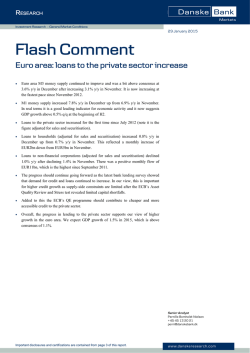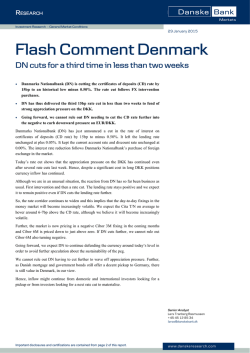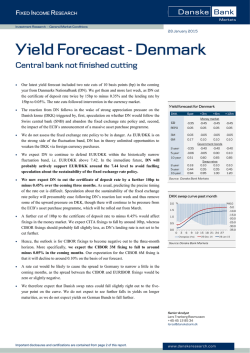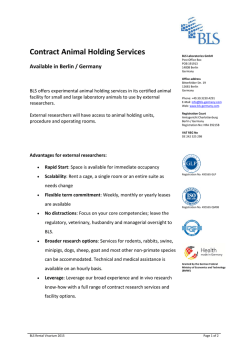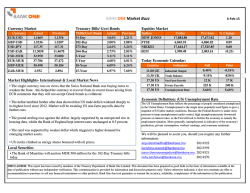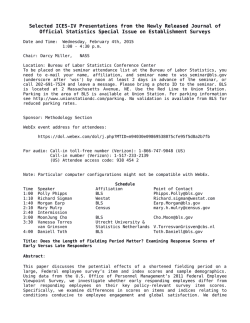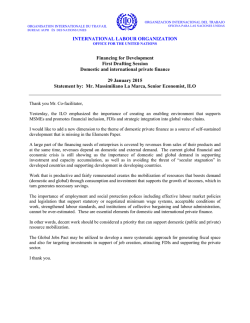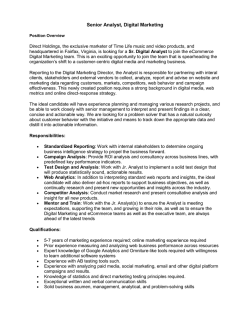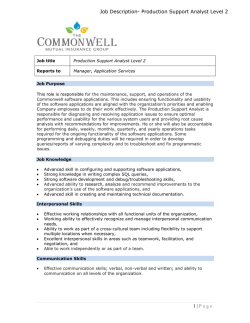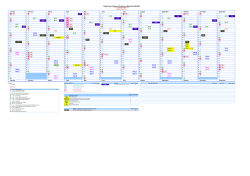
Monitor: US labour market keeps improving
Investment Research — General Market Conditions 2 February 2015 Monitor US labour market: keeps improving Job report preview Our model estimates non-farm payroll for January at 215,000, which is marginally below consensus at 231,000. Government job growth has averaged 9,000 per month over the past six months and our model suggests a slightly higher pace of growth in January (+15,000). We expect the unemployment rate to stay constant at 5.6%, after falling 0.2 points in December. Over the past three months, labour force growth has averaged 95,000 per month, while household employment has grown 278,000 per month. With employment growth likely to decline in January, the downward drift in the unemployment rate could take a breather before continuing lower. The largest surprise in the December release was a fall in average hourly earnings. Hourly earnings in the private sector fell 0.2% m/m, taking the annual wage inflation proxy to 0.5% in Q4, down from 1.5% in Q3. However, the more correct measure, the Employment Cost Index released with the Q4 GDP data on Friday showed a much more muted slowdown in wage inflation. Hence, we expect a significant rebound in average hourly earnings in January. Danske Bank forecasts (January) Non-farm Payrolls -Private -Manufacturing -Service -Construction -Mining and logging -Government Unemployment rate DB 215 200 15 5,6% Consensus 231 222 10 9 5,6% Source: Macrobond Financial, Danske Bank Markets calculations We expect a rebound in hourly earnings General condition of the US labour market Employment growth has been strong over the past four months and leading indicators of the labour market such as gains in temporary help services, the level of initial jobless claims and the labour market differential from the Conference Board Consumer confidence survey have all improved. One might have thought that the improving labour market and GDP growth of 4.8% annualised in the second half of last year had brought some discouraged workers back into the labour force. However, labour participation rates have merely stabilised and remain low for most age groups. This has accelerated the move lower in unemployment and we are getting closer to the latest FOMC estimate of longer term unemployment (NAIRU), which is at 5.4%. However, other slack indicators suggest that there is still a significant underutilisation of labour. The number of marginally attached workers and people who work part time for economic reasons is still elevated. Although wage inflation (measured by the wages and salary component of the Employment Cost Index) has picked up recently, wage growth remains subdued compared with historical standards. This raises the question of what the ‘true’ level of the NAIRU is. The FOMC will have to deal with this question in March when it publishes new economic projections. Source: Macrobond Financial, BLS Our model is predicting slightly below consensus Source: Macrobond Financial, BLS Senior Analyst Signe Roed-Frederiksen +45 45 12 82 29 [email protected] Assistant Analyst Louise Randrup Noe [email protected] Important disclosures and certifications are contained from page 8 of this report. Prior 252 240 17 173 48 2 12 5,6% www.danskeresearch.com Monitor US labour market in one chart The labour market keeps improving but significant slack remains – (outwards moves indicate stronger labour market) December 2007 December 2009 Temporary help wanted Leading indicators January 2014 Payroll employment June 2014 December 2014 Job openings Employer behavior Unable to fill job openings Hires Initial claims The index compares the labour market conditions in recent months with the prerecession peak in employment in December 2007 (Index 100) and the post recession trough in employment in December 2009 (Index 0) Hiring plans Job finding Job availability Part time for economic reason Quits Utilization (slack) Marginally attached Confidence Unemployment Note: The diagram shows the level of tightness of different US labour market key figures at different times, compared with the level of the same figures in December 2007 (index=100) and December 2009 (index = 0). Counter cyclical figures (unemployment rate, jobless claims, marginally attached and work part time for economic reasons) are inverted; thus, the higher index (the further from the middle) the better (tighter) is the state of the labour market JOLTS data for December is an average of October and November data Source: BLS (JOLTS), Macrobond Financial 2| 2 February 2015 www.danskeresearch.com Monitor Models and leading indicators Payrolls model ISM employment and US non-farm payrolls Source: Macrobond Financial, Danske Bank Markets calculations Source: Macrobond Financial, ISM, BLS Initial jobless claims Small business hiring plans next 3 months Source: Macrobond Financial, U.S. Department of Labor Source: Macrobond Financial, NFIB Wage pressure and unemployment rate Worker confidence and unemployment rate Source: Macrobond Financial, Danske Bank Markets Source: Macrobond Financial 3| 2 February 2015 www.danskeresearch.com Monitor Unemployment measures Unemployment rate Unemployment decomposed by duration Source: Macrobond Financial, FOMC, BLS Source: Macrobond Financial, BLS Long term unemployment rate Short-term unemployment rate Source: Macrobond Financial, BLS Source: Macrobond Financial, BLS Long term unemployment as % of total unemployed Marginally attached workers Source: Macrobond Financial, BLS Source: Macrobond Financial, BLS 4| 2 February 2015 www.danskeresearch.com Monitor Participation Participation rate, all Participation rate, 25-34, men Source: Macrobond Financial, BLS Source: Macrobond Financial, BLS Participation rate, 35-44, men Participation rate, 45-54 and 55+, men Source: Macrobond Financial, BLS Source: Macrobond Financial, BLS Employment measures Non-farm payroll ADP private payrolls Source: Macrobond Financial, BLS Source: Macrobond Financial, ADP 5| 2 February 2015 www.danskeresearch.com Monitor Part time employed for economic reasons Employment to population ratio Source: Macrobond Financial, BLS Source: Macrobond Financial, BLS Wage growth and inflation Average hourly earnings and Employment Cost Index Hourly earnings, production and non-supervisory Source: Macrobond Financial, BEA Source: Macrobond Financial, BLS Fundamentals support higher wage growth Worker confidence is slowly rising – will wages follow? Source: Macrobond Financial, BLS Source: Macrobond Financial, Conference Board, BLS 6| 2 February 2015 www.danskeresearch.com Monitor The employer’s perspective Unemployment and time to fill vacancies Short-term unemployment and time to fill vacancies Source: Macrobond Financial, BLS Source: Macrobond Financial, BLS The rate of new job openings and hire rate (3M moving average) Temporary employment and unemployment Source: Macrobond Financial, BLS Source: Macrobond Financial, BLS 7| 2 February 2015 www.danskeresearch.com Monitor Disclosures This research report has been prepared by Danske Bank Markets, a division of Danske Bank A/S (‘Danske Bank’). The authors of this research report Signe Roed-Frederiksen, Senior Analyst, and Louise Randrup Noe, Assistant Analyst. Analyst certification Each research analyst responsible for the content of this research report certifies that the views expressed in this research report accurately reflect the research analyst’s personal view about the financial instruments and issuers covered by the research report. Each responsible research analyst further certifies that no part of the compensation of the research analyst was, is or will be, directly or indirectly, related to the specific recommendations expressed in the research report. Regulation Danske Bank is authorised and subject to regulation by the Danish Financial Supervisory Authority and is subject to the rules and regulation of the relevant regulators in all other jurisdictions where it conducts business. Danske Bank is subject to limited regulation by the Financial Conduct Authority and the Prudential Regulation Authority (UK). Details on the extent of the regulation by the Financial Conduct Authority and the Prudential Regulation Authority are available from Danske Bank on request. The research reports of Danske Bank are prepared in accordance with the Danish Society of Financial Analysts’ rules of ethics and the recommendations of the Danish Securities Dealers Association. Conflicts of interest Danske Bank has established procedures to prevent conflicts of interest and to ensure the provision of highquality research based on research objectivity and independence. These procedures are documented in Danske Bank’s research policies. Employees within Danske Bank’s Research Departments have been instructed that any request that might impair the objectivity and independence of research shall be referred to Research Management and the Compliance Department. Danske Bank’s Research Departments are organised independently from and do not report to other business areas within Danske Bank. Research analysts are remunerated in part based on the overall profitability of Danske Bank, which includes investment banking revenues, but do not receive bonuses or other remuneration linked to specific corporate finance or debt capital transactions. Financial models and/or methodology used in this research report Calculations and presentations in this research report are based on standard econometric tools and methodology as well as publicly available statistics for each individual security, issuer and/or country. Documentation can be obtained from the authors on request. Risk warning Major risks connected with recommendations or opinions in this research report, including a sensitivity analysis of relevant assumptions, are stated throughout the text. Date of first publication See the front page of this research report for the date of first publication. General disclaimer This research has been prepared by Danske Bank Markets (a division of Danske Bank A/S). It is provided for informational purposes only. It does not constitute or form part of, and shall under no circumstances be considered as, an offer to sell or a solicitation of an offer to purchase or sell any relevant financial instruments (i.e. financial instruments mentioned herein or other financial instruments of any issuer mentioned herein and/or options, warrants, rights or other interests with respect to any such financial instruments) (‘Relevant Financial Instruments’). The research report has been prepared independently and solely on the basis of publicly available information that Danske Bank considers to be reliable. While reasonable care has been taken to ensure that its contents are not untrue or misleading, no representation is made as to its accuracy or completeness and Danske Bank, its affiliates and subsidiaries accept no liability whatsoever for any direct or consequential loss, including without limitation any loss of profits, arising from reliance on this research report. 8| 2 February 2015 www.danskeresearch.com Monitor The opinions expressed herein are the opinions of the research analysts responsible for the research report and reflect their judgement as of the date hereof. These opinions are subject to change, and Danske Bank does not undertake to notify any recipient of this research report of any such change nor of any other changes related to the information provided in this research report. This research report is not intended for retail customers in the United Kingdom or the United States. This research report is protected by copyright and is intended solely for the designated addressee. It may not be reproduced or distributed, in whole or in part, by any recipient for any purpose without Danske Bank’s prior written consent. Disclaimer related to distribution in the United States This research report is distributed in the United States by Danske Markets Inc., a U.S. registered broker-dealer and subsidiary of Danske Bank, pursuant to SEC Rule 15a-6 and related interpretations issued by the U.S. Securities and Exchange Commission. The research report is intended for distribution in the United States solely to ‘U.S. institutional investors’ as defined in SEC Rule 15a-6. Danske Markets Inc. accepts responsibility for this research report in connection with distribution in the United States solely to ‘U.S. institutional investors’. Danske Bank is not subject to U.S. rules with regard to the preparation of research reports and the independence of research analysts. In addition, the research analysts of Danske Bank who have prepared this research report are not registered or qualified as research analysts with the NYSE or FINRA but satisfy the applicable requirements of a non-U.S. jurisdiction. Any U.S. investor recipient of this research report who wishes to purchase or sell any Relevant Financial Instrument may do so only by contacting Danske Markets Inc. directly and should be aware that investing in nonU.S. financial instruments may entail certain risks. Financial instruments of non-U.S. issuers may not be registered with the U.S. Securities and Exchange Commission and may not be subject to the reporting and auditing standards of the U.S. Securities and Exchange Commission. 9| 2 February 2015 www.danskeresearch.com
© Copyright 2026
